- Home
- Dick Francis
Lester: The Official Biography Page 11
Lester: The Official Biography Read online
Page 11
Lester himself watched the Derby on television in his sitting-room and saw Psidium, on whom he had once won, and could, if he had chosen, have ridden in the big race, beat a poor field at the outside price of 66-1.
It was considered at the time likely that someone in the stable had helped Pinturischio's nobblers; had shown them a way in and pointed them to the right horse. Not until four or five years later was this theory proved correct, when the villains were finally detected. The inside man proved to Lester's and everyone's disgust to be one of the best lads in the stable. He had cared for one great horse and at the same time ruined another. He had taken owners' compliments and thanks and cynically robbed Sir Victor Sassoon behind his back not only of another possible Derby but of the colt's future at stud.
St. Paddy, having wintered well and developed, proved one of the stable's top 1961 earners, going from strength to strength. For openers he went to Sandown to run against only two opponents, one of which was his own pacemaker, Sunny Way. As St. Paddy was thought to be quietening down with age, Lester rode him to the start without the dropped noseband. A mistake. St. Paddy gave signs of his old trick of taking charge and, to stop him, Lester guided him towards one of the steeplechase fences. St. Paddy immediately began to measure his stride to jump, and Lester had to pull him out again. They did reach the start in fair control, however, and in the race St. Paddy cantered nonchalantly home to win, untaxed.
Next time out (restrained down to the start), he went to Royal Ascot and dealt equally disdainfully with three contestants in the Hardwicke Stakes (one of them again Sunny Way), leaving Vincent O'Brien's Die Hard, on which Lester later that year won the Ebor, struggling helplessly in his wake.
St. Paddy next went to the Eclipse Stakes at Sandown in July where he led from start to finish, Lester smoothly holding off the supporting cast of six. Press reports noted that all three wins were "easy", because St. Paddy was never off the bit.
Considered unbeatable, St. Paddy set off in the King George VI and Queen Elizabeth Stakes in soft going on a windy day at Ascot later the same month, and there met his Waterloo in the shape of the French horse Right Royal V, who won by three clear lengths.
"He murdered me," Lester says succinctly. St. Paddy, in desperation let off the bit, still couldn't quicken. A four-year-old, he was giving a stone in weight to his threeyear-old conqueror.
On this downbeat note, one of the era's great racing _partnerships came to an end: in August the news came that Sir Victor Sassoon, at seventynine, had died of a heart attack at home in the Bahamas.
Reeling from this second great blow, the Murless stable again rallied and went on with business. Aurelius, who had missed the Derby because of the hard ground and had won the King Edward VII Stakes instead (that race again!), went forth and doggedly clung on to a one and a half length lead in the St. Leger, bringing home at least one Classic as consolation.
St. Paddy, now carrying the colours of Lady Sassoon, came out again in September, and (strongly held) won the jockey Club Stakes at Newmarket, conclusively beating High Hat who had earlier defeated Lester and Petite Etoile in the Aly Khan Memorial. St. Paddy finally ran in Newmarket's Champion Stakes in October, but again he was outrun by a French horse, this time the practically unknown Bobar II.
St. Paddy couldn't quicken at the end and lost by three-quarters of a length.
A line was drawn under a brilliant career, and St. Paddy went to stud. Because of his own insecurities, his progeny were seldom bold and the runaway star was not an outstanding sire. Connaught, second in the 1968 Derby, was the best of his "get".
Lester rode St. Paddy in all of his races: two also-rans, three seconds and nine firsts.
-
11 Injuries: Part 1
RACEHORSES are not safe, and no one who rides them over a long period escapes injury of some sort. It's considered inevitable that jump jockeys should get hurt occasionally, but the level of risk accepted by Flat race jockeys is curiously underestimated. There they are, perched over the shoulders of half a ton of athletic muscle travelling at up to forty miles an hour, with nothing but their sense of balance between them and the crunching crash. Flat race jockeys look at the risk clearly: much of the public doesn't see it at all.
For Lester, the first serious involuntary dismount at top speed occurred on 31 March 1951, when he was fifteen.
On the day of the Lincolnshire Handicap in which he was due to ride Seconds Out, owned by Jack Solomons the boxing promoter, Lester rode in the afternoon's first event, the Castle Plate. His mount, a filly, Pandite, started favourite and ran reasonably well, with Lester in third place fifty yards from the winning post going flat out for the finish. Without warning, Pandite went down, hurling Lester to the ground. Pandite lay helplessly on her side, sorely injured with a broken leg. Lester lay beside her, cradled in the arms of two ambulancemen who went to his aid; and on them all, as so often in Britain, it poured with rain.
Pandite was put out of her misery on the spot. Lester, clutching a badly broken collar-bone, was carried by the ambulance-men off the course, and driven from there to Lincoln County Hospital for X-rays, bone setting and strapping. Iris, of course, went with him and later that day drove her sore and shaken son home to Lambourn, whose only consolation was that he hadn't missed winning the Lincoln. Seconds Out lost on points, finishing well down the field.
By the next morning, Lester was comfortable, smiling, planning to keep fit by walking, and determining on the earliest possible come-back. He made that in two weeks and two days, riding in five races at Birmingham on his first day's reappearance, and winning the last on Grey Magic, beating the odds-on favourite.
At fifteen, a lifelong pattern was in this way set: the real agonising pain dealt with as quickly as possible, the recovery speedy, the courage intact. The list of Lester's subsequent injuries, long chiefly because of his long career, would have horrified and deterred many a strong man: Lester simply thinks it amazing that anyone should consider tumbling off horses any sort of reason for not getting back on immediately.
For all self-employed jockeys, the inducement to return to the saddle is ostensibly two-fold. First, it's boring sitting around doing nothing. Second, sitting around doing nothing is expensive. Selfemployed people cannot claim unemployment benefits, and no work means no income. All the same, to say that the indecent scramble back to the saddle of almost every jockey, not just Lester, is fired by finance is to misunderstand the underlying psychology. The need to earn is often given as the public reason for the fastest possible return, because the need to earn is easily understood. The deeper need for speed, for competition, for exercising one's skill, for winning-all that lies in a shadowy compulsive area of self-fulfilment that can be destroyed by too much dissection.
When the compulsion fades, when it's gone, the jockey stops riding in races. Money in itself is not motivation enough. Lester himself says jockeyship is "just a job", a statement his actions belied. For Lester, the post-injury urge to return to raceriding was instinctive and not to be analysed. Enough to say that in him it had been from the beginning consistently and overwhelmingly strong.
Lester's 1951 season ended even worse than it began, with another and much more prolonged sojourn in hospital.
In August, in the last race at Lingfield, the favourite, Persian Wood, fell without warning coming round the last bend into the straight, bringing down Lester on No Light who was tracking him closely. Eph Smith, riding Persian Wood, broke his collar-bone and some ribs, and Persian Wood, with a broken leg, had to be put down.
Lester's severe injuries were caused not so much by the fall itself as by hitting at high speed one of the concrete posts supporting the rails. Those concrete uprights were over and over again the source of terrible damage to jockeys and horses, and it took thirty years from Lester's accident for them to be replaced on most courses by plastic posts which would snap in a collision, not mangle the bodies of man or beast.
Lester broke his leg, his hip and his collar-bone, multi
ple injuries which put him in East Grinstead Hospital for three weeks and plaster for three months. Once the bone-setting operations were over he was cosseted like mad by the East Grinstead nurses and given no-frills devotion in Lambourn by his parents, but, legs being notoriously slow to mend, it was not until well after the Flat season ended in November that he was able to get back on a horse.
After these dramatic goings on, it was thirteen years before anything more serious than cuts and bruises came Lester's way, but on 27 September 1964, in Paris, the run of good luck drastically ended.
By then he was adult (twenty-eight), married, a father, and set fair to become champion jockey for the second time. The championship was very important to him at that point as, since winning it for the first time in 1960, he had seen it appropriated for the following three years by Scobie Breasley. On the day he rode in Paris, Lester's score stood at 135, with another Australian jockey, Ron Hutchinson, at his heels on 123, and Scobie third at 118. Lester was hungry to regain the crown, and he couldn't know that it would be his own for the next eight years.
He rode Persian Garden for Noel Murless in the Prix Henry Delamarre at Longchamp, and at about half way, when lying about fifth, his mount crumpled and fell. Lester says he thinks he was squeezed for room and that his horse caught the heels of another. In any case, he was pitched straight off, and the two horses immediately behind fell on top of him.
Lester, unconscious for half an hour, was carried off on a stretcher to go to hospital, lying white and silent under a fringed car rug. One of the other fallen jockeys, Marcel Depalmas, went with him. The third, Roger Poincelet, walked away unhurt and later the same day won the Prix de Sablonville on The Marshall.
The Stewards, holding a subsequent enquiry, blamed Yves Saint-Martin, riding Acer, for the squeeze and handed out a month's suspension, saying at the same time that they didn't think he had caused the disaster intentionally. Either one is guilty,-or one is not!
Lester and his French champion-elect counterpart were thus both in one incident prevented from riding in the 1964 Arc de Triomphe, run the following Sunday, but in the event neither Saint-Martin's mount, Jour et Nuit, nor Lester's, Royal Avenue, added to their intended jockeys' disappointments.
Lester, still unconscious, and Depalmas, concussed and delirious, were taken to the Clinique Jouvenet at St. Cloud, always the care centre for racing mishaps. One enterprising journalist described Depalmas as on his feet and giving a lucid account of the triple fall after a "check-up" at the hospital, but in fact the lightweight Frenchman was talking disjointed nonsense in a southern French accent in a two-bed ward shared with the non-speaking and badly battered Lester.
Julie Murless, Noel's daughter, telephoned to Susan back home in Newmarket, and in tears told her that Lester might have fractured his skull. Susan, four and a half months pregnant with their second child, was taken by a close friend, Charles St.
George, in a private plane to Paris the following day, and went to the clinic knowing only that Lester was alive. She found him in the hallway outside the ward, not only alive but sleepily conscious and sitting in a wheel-chair. That was the good news.
The bad, which she and Lester successfully hid from the Press, was that Lester's face was cut and severely bruised, and all the left shoulder, arm and side of his body the same, and that he had double vision and an intense persisting headache.
"A spokesman" at the hospital helpfully and publicly announced that there was "no fracture". Both Lester and Susan say there was a hairline fracture at the base of the skull, and in view of the severity and persistence of that fall's effect on his brain, they are certainly right.
The English newspapers were predicting Lester to be "Out for six weeks" or "Out for the rest of the season". The season would end on 31 October, less than five weeks ahead. Lester, his mind on his fragile lead in the championship, had other ideas.
Susan moved into the clinic to be near to tend her husband, and the delirious Depalmas was moved to another ward, but because he didn't really know where he was, he kept wandering back in again, as in a farce; at least he kept the Piggotts' sense of humour alive through the anxious days.
With his customary resilience, Lester was back on his feet by Friday and on the Saturday, six days after the crash and the day before the Arc, he and Susan flew back to Heathrow. They were worried about dodging the airport photographers, as Lester, with his groggily shaky legs and severely cut and bruised face, didn't want the world in general to see him. He was saved, as it happened, by the Beatles, who were flying in from America on the same day. All the photographers pointed their waiting lenses the Beatles' way, and Lester brought his frail state of health home unnoticed.
He rested for almost a week, the double vision and the headaches persisting, and then rode a hack on Newmarket Heath, intending to race the next day. On his return from the exercise, however, he announced he was "not satisfied with his condition", which literally meant "can't see, head thumping, sore and stiff and too weak to win". He would be thoroughly fit to ride on the following Wednesday, he said firmly: and Ron Hutchinson meanwhile closed the championship gap to five.
Wednesday came and went, but by the following Friday the fitness was more or less a fact, and in the Houghton Stakes at Newmarket Lester rode with paramount strength to get Alan Adare home by a head.
Poor Ron Hutchinson got to within two of Lester's total during the last week of the season, but in the end Lester won by four, at 140 to Ron's 136. Scobie Breasley finished third with 123.
Very probably under the strict rules later introduced to prevent jockeys from riding with insufficiently mended injuries, Lester would have been forced to sit around for longer than the nineteen days it took him to get back to winning. The modern rules might possibly have given Ron Hutchinson the championship. But there it is; Lester successfully suppressed the seriousness and extent of the damage, and he could make his own choices, and he did by will-power take his title.
The double vision lasted a month. The headaches went on for fifteen years, recurring at periods of stress, and often during flights, and unpredictably at other times. Although a faintly anxious severity had for long been his accustomed public face, it is possible that for fifteen years the headaches accounted for the extra strain apparent in so many photographs. It has been noticeable in latter years that the Piggott smile is a more common occurrence, and that Lester is much more relaxed. It's possible it is the headaches which relaxed: they plough no more furrows in his forehead.
-
12 Suspensions: Part 2
BETWEEN the restoration of his licence in 1954 and the spring of 1962, Lester had been before the Stewards at scattered intervals for a bunch of various and repeated misdemeanors, such as "anticipating the start", "excessive use of the whip", "starting in the wrong place", "not keeping a straight course" and "not riding out for third place". The last infringement is common to all jockeys, who hate to be hard on a horse if it can't win. The betting public on the other hand rises to understandable peaks of fury when their place bets go visibly down the drain. The rules insist a horse must be ridden right out, regardless of whether or not a hard finish will exhaust or sicken the horse for the future. Maybe the rules are right, maybe they are not: the argument goes constantly on.
Lester was also cautioned for a broken stirrup leather (should look after his equipment properly), for being two minutes late in weighing out (allowed to race), and for forgetting to weigh in when finishing fourth (fined 10 sovs.).
Only in 1959, however, was he actually suspended, and again, strangely enough, because of an incident involving his cousin, Bill Rickaby. No one nowadays can check with Bill Rickaby about his impressions of this or any other race, as very sadly he was involved some years ago in a car crash in Hong Kong, which left his memory impaired.
At an evening meeting at Nottingham in June, Lester, riding Astrador, swerved left suddenly against Bill Rickaby's Roi de Perse, but then straightened and went on to finish second, by a neck. Roi de Pe
rse, hampered, couldn't recover to come in better than fifth in a close-packed field. There were barely two lengths between the first and fifth.
Astrador (trained by Noel Murless) was disqualified and placed last, and Lester was suspended for the rest of the two-day meeting for rough riding. No one seems to have taken into account the fact that on its previous running, Astrador had similarly swerved left with no warning. Horses, as Lester says, are unpredictable, and do not run on rails.
The suspension followed less than a week after he had brilliantly won the Oaks on Petite Etoile. The events of 1962 were grimmer and altogether different, and again left Lester white-faced and bitter.
He had ridden many times over the years for a trainer called Bob Ward who had a stable at Hednesford in Staffordshire. Bob Ward was in general suspected by the Stewards of not running his horses fairly; of sending them out for "easy" races to do no good and be reduced in the handicap, and then running them to win carrying a lighter weight and all the stable's money.
Bob Ward was by no means alone in this practice which went on, to some extent, in most stables in the land, and had done from time immemorial. In Bob Ward's case, however, the Stewards considered it blatant, and they were out to catch him. Nemesis was waiting around like a whole new thunderstorm looking for an excuse to happen, and it was Lester's bad luck that time that he got struck by its lightning.

 Bolt
Bolt Proof
Proof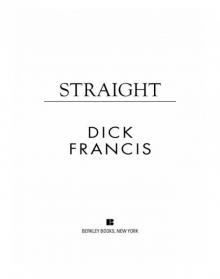 Straight
Straight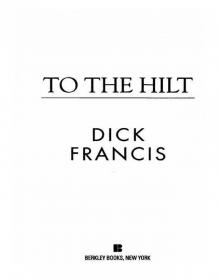 To the Hilt
To the Hilt High Stakes
High Stakes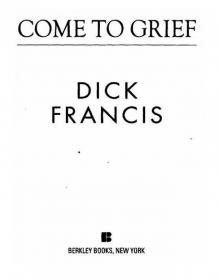 Come to Grief
Come to Grief Odds Against
Odds Against Knock Down
Knock Down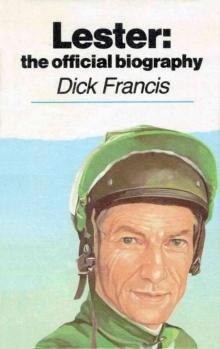 Lester: The Official Biography
Lester: The Official Biography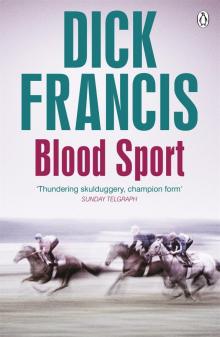 Blood Sport
Blood Sport Trial Run
Trial Run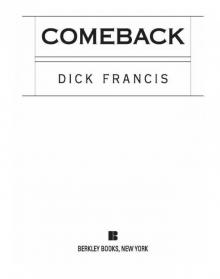 Comeback
Comeback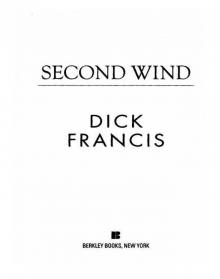 Second Wind
Second Wind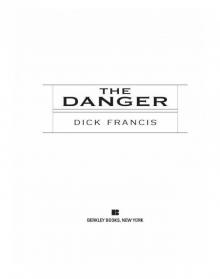 The Danger
The Danger Under Orders sh-4
Under Orders sh-4 Break In
Break In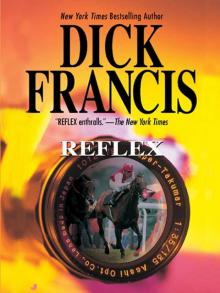 Reflex
Reflex Dead Heat
Dead Heat Dick Francis's Damage
Dick Francis's Damage The Edge
The Edge Wild Horses
Wild Horses Longshot
Longshot Slay Ride
Slay Ride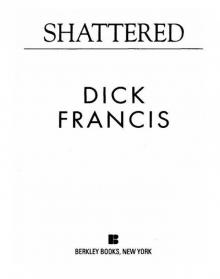 Shattered
Shattered Banker
Banker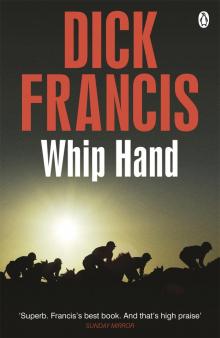 Whip Hand
Whip Hand Even Money
Even Money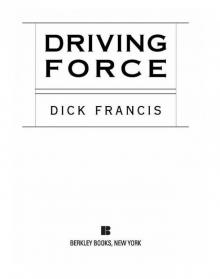 Driving Force
Driving Force Decider
Decider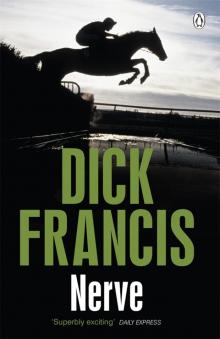 Nerve
Nerve Hot Money
Hot Money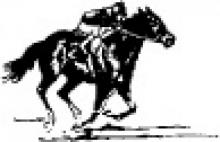 Field of Thirteen
Field of Thirteen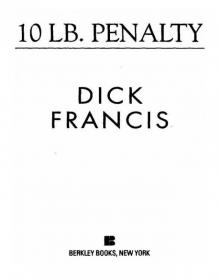 10 lb Penalty
10 lb Penalty Dead Cert
Dead Cert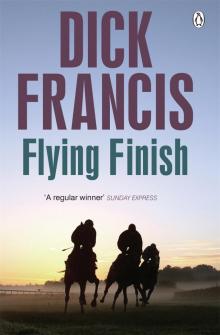 Flying Finish
Flying Finish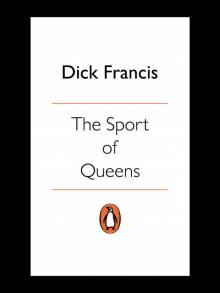 The Sport of Queens
The Sport of Queens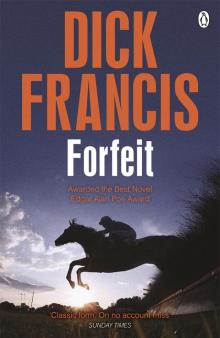 Forfeit
Forfeit Smokescreen
Smokescreen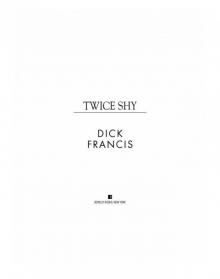 Twice Shy
Twice Shy Silks
Silks Enquiry
Enquiry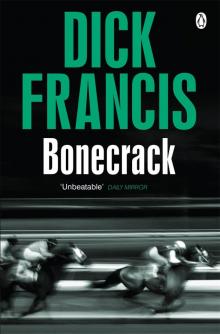 Bonecrack
Bonecrack For Kicks
For Kicks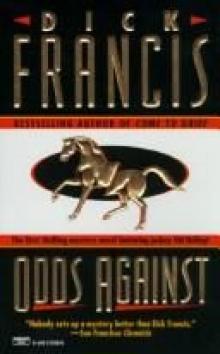 Odds against sh-1
Odds against sh-1 Rat Race
Rat Race Crossfire
Crossfire